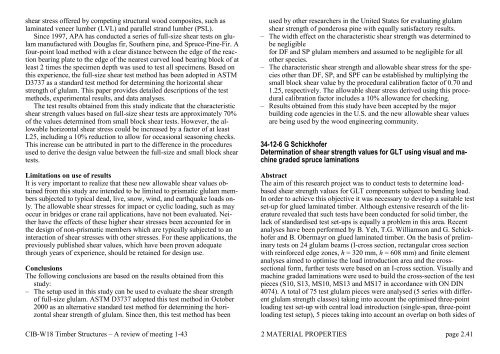CIB-W18 Timber Structures – A review of meeting 1-43 2 MATERIAL ...
CIB-W18 Timber Structures – A review of meeting 1-43 2 MATERIAL ...
CIB-W18 Timber Structures – A review of meeting 1-43 2 MATERIAL ...
- TAGS
- timber
- structures
- cib-w18.com
Create successful ePaper yourself
Turn your PDF publications into a flip-book with our unique Google optimized e-Paper software.
shear stress <strong>of</strong>fered by competing structural wood composites, such as<br />
laminated veneer lumber (LVL) and parallel strand lumber (PSL).<br />
Since 1997, APA has conducted a series <strong>of</strong> full-size shear tests on glulam<br />
manufactured with Douglas fir, Southern pine, and Spruce-Pine-Fir. A<br />
four-point load method with a clear distance between the edge <strong>of</strong> the reaction<br />
bearing plate to the edge <strong>of</strong> the nearest curved load bearing block <strong>of</strong> at<br />
least 2 times the specimen depth was used to test all specimens. Based on<br />
this experience, the full-size shear test method has been adopted in ASTM<br />
D3737 as a standard test method for determining the horizontal shear<br />
strength <strong>of</strong> glulam. This paper provides detailed descriptions <strong>of</strong> the test<br />
methods, experimental results, and data analyses.<br />
The test results obtained from this study indicate that the characteristic<br />
shear strength values based on full-size shear tests are approximately 70%<br />
<strong>of</strong> the values determined from small block shear tests. However, the allowable<br />
horizontal shear stress could be increased by a factor <strong>of</strong> at least<br />
L25, including a 10% reduction to allow for occasional seasoning checks.<br />
This increase can be attributed in part to the difference in the procedures<br />
used to derive the design value between the full-size and small block shear<br />
tests.<br />
Limitations on use <strong>of</strong> results<br />
It is very important to realize that these new allowable shear values obtained<br />
from this study are intended to be limited to prismatic glulam members<br />
subjected to typical dead, live, snow, wind, and earthquake loads only.<br />
The allowable shear stresses for impact or cyclic loading, such as may<br />
occur in bridges or crane rail applications, have not been evaluated. Neither<br />
have the effects <strong>of</strong> these higher shear stresses been accounted for in<br />
the design <strong>of</strong> non-prismatic members which are typically subjected to an<br />
interaction <strong>of</strong> shear stresses with other stresses. For these applications, the<br />
previously published shear values, which have been proven adequate<br />
through years <strong>of</strong> experience, should be retained for design use.<br />
Conclusions<br />
The following conclusions are based on the results obtained from this<br />
study:<br />
<strong>–</strong> The setup used in this study can be used to evaluate the shear strength<br />
<strong>of</strong> full-size glulam. ASTM D3737 adopted this test method in October<br />
2000 as an alternative standard test method for determining the horizontal<br />
shear strength <strong>of</strong> glulam. Since then, this test method has been<br />
used by other researchers in the United States for evaluating glulam<br />
shear strength <strong>of</strong> ponderosa pine with equally satisfactory results.<br />
<strong>–</strong> The width effect on the characteristic shear strength was determined to<br />
be negligible<br />
for DF and SP glulam members and assumed to be negligible for all<br />
other species.<br />
<strong>–</strong> The characteristic shear strength and allowable shear stress for the species<br />
other than DF, SP, and SPF can be established by multiplying the<br />
small block shear value by the procedural calibration factor <strong>of</strong> 0.70 and<br />
1.25, respectively. The allowable shear stress derived using this procedural<br />
calibration factor includes a 10% allowance for checking.<br />
<strong>–</strong> Results obtained from this study have been accepted by the major<br />
building code agencies in the U.S. and the new allowable shear values<br />
are being used by the wood engineering community.<br />
34-12-6 G Schickh<strong>of</strong>er<br />
Determination <strong>of</strong> shear strength values for GLT using visual and machine<br />
graded spruce laminations<br />
Abstract<br />
The aim <strong>of</strong> this research project was to conduct tests to determine loadbased<br />
shear strength values for GLT components subject to bending load.<br />
In order to achieve this objective it was necessary to develop a suitable test<br />
set-up for glued laminated timber. Although extensive research <strong>of</strong> the literature<br />
revealed that such tests have been conducted for solid timber, the<br />
lack <strong>of</strong> standardised test set-ups is equally a problem in this area. Recent<br />
analyses have been performed by B. Yeh, T.G. Williamson and G. Schickh<strong>of</strong>er<br />
and B. Obermayr on glued laminated timber. On the basis <strong>of</strong> preliminary<br />
tests on 24 glulam beams (I-cross section, rectangular cross section<br />
with reinforced edge zones, h = 320 mm, h = 608 mm) and finite element<br />
analyses aimed to optimise the load introduction area and the crosssectional<br />
form, further tests were based on an I-cross section. Visually and<br />
machine graded laminations were used to build the cross-section <strong>of</strong> the test<br />
pieces (S10, S13, MS10, MS13 and MS17 in accordance with ON DIN<br />
4074). A total <strong>of</strong> 75 test glulam pieces were analysed (5 series with different<br />
glulam strength classes) taking into account the optimised three-point<br />
loading test set-up with central load introduction (single-span, three-point<br />
loading test setup), 5 pieces taking into account an overlap on both sides <strong>of</strong><br />
<strong>CIB</strong>-<strong>W18</strong> <strong>Timber</strong> <strong>Structures</strong> <strong>–</strong> A <strong>review</strong> <strong>of</strong> <strong>meeting</strong> 1-<strong>43</strong> 2 <strong>MATERIAL</strong> PROPERTIES page 2.41














